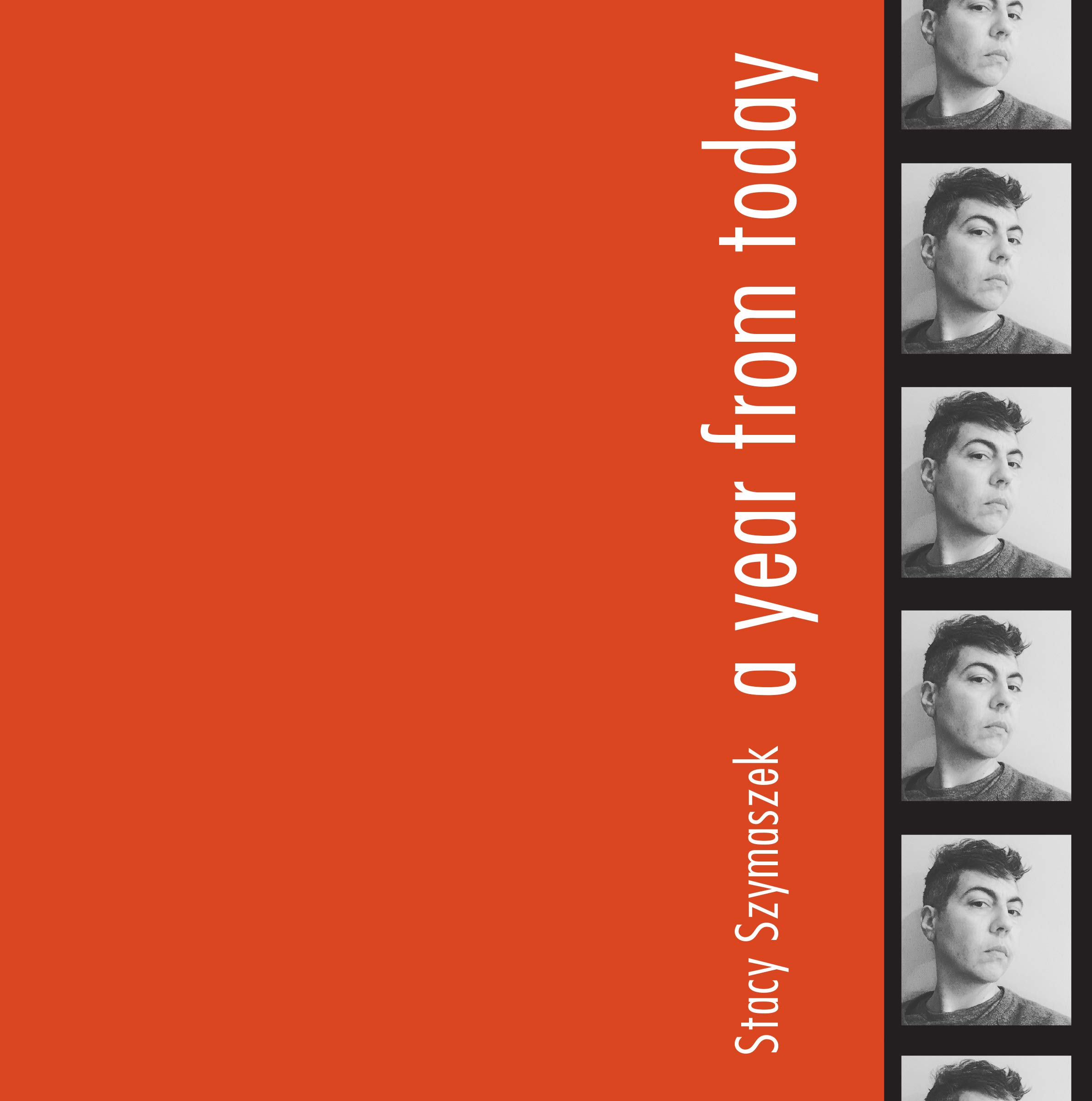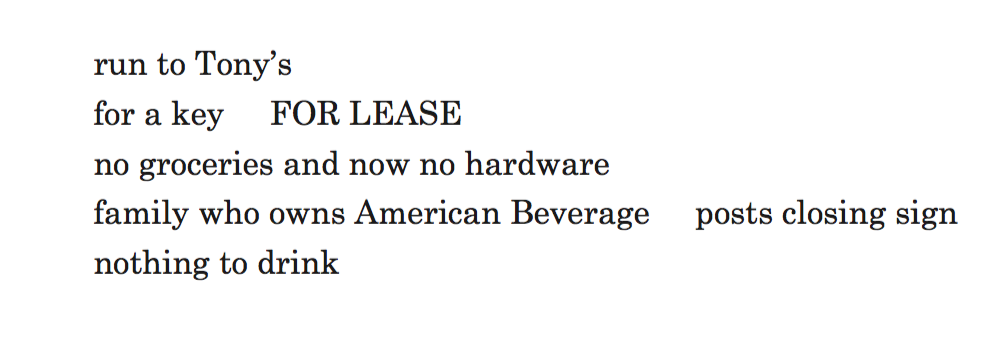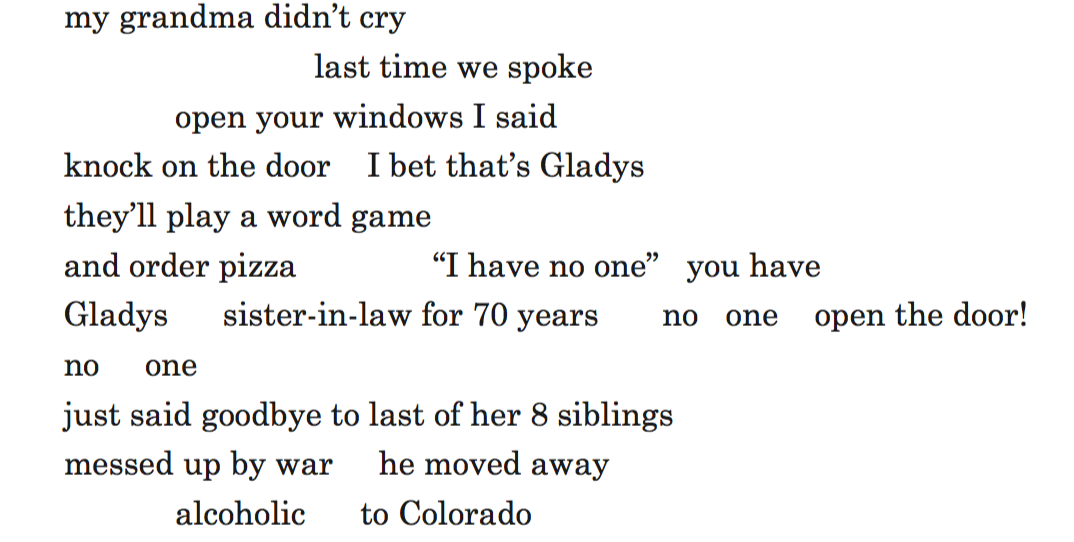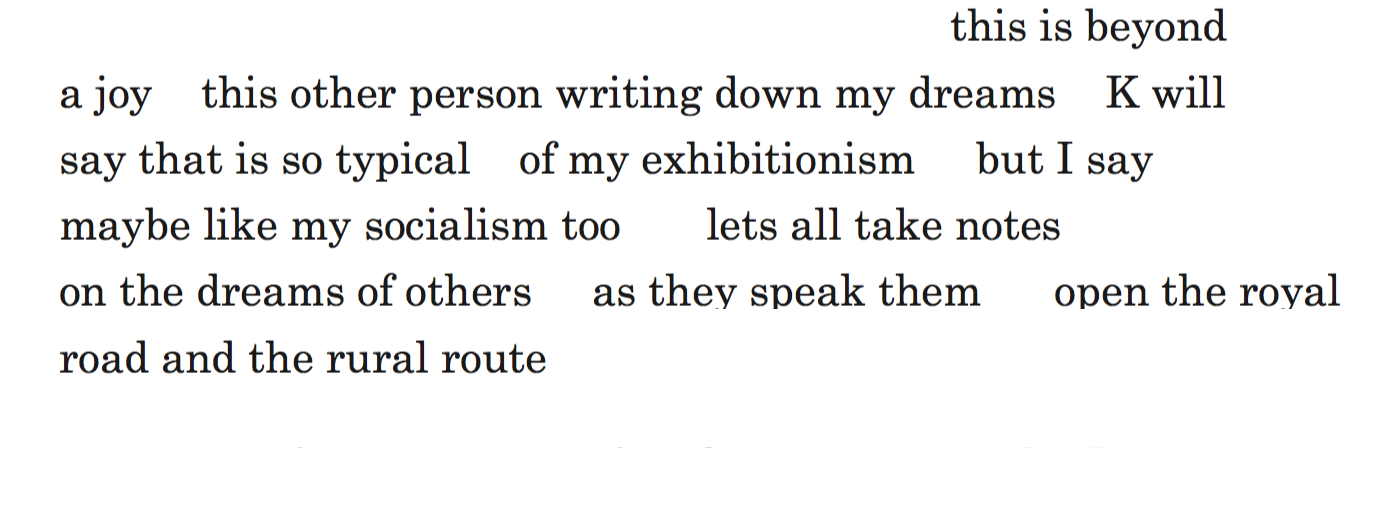
Format: 155 pp., paperback; Publisher: Nightboat Books; Color: Tangerine; Font: Century Schoolbook; Price: $17. Design: Margaret Tedesco. Months elapsed: twelve. Trains running late: dozens. Representative quote: “did anyone / else’s dentist have the sign / ignore your teeth and they’ll go away the landmark / isn’t going anywhere nor is the landlord”
Central Question: What does a practice of daily writing do for the poem of traversing urban space?
Take a poem for a walk in a city and you’ll put your foot right into history, maybe. The poem of traversing a city can plot what the philosopher Henri Lefebvre called the “production of space”: the organization of human life as the result of just so many migrations, needs, and struggles. Those struggles aren’t more important in a city versus any other organization of space—but they are more dramatized, by virtue of the sheer density that juxtaposes some people’s misery and others’ comfort. Alternately, the poem of walking through a city could produce something like a document of leisure, a postcard of somebody’s picturesque bohemia. (Benjamin is apt: “Landscape—that’s what the city becomes for the flâneur.”) Whether and how a project stitches a historical understanding into its flânerie has less to do with content per se than with genre, which presents an image of urban space rearranged on its own formal terms. That matters for Stacy Szymaszek’s A Year From Today (Nightboat Books, 2018), a journal poem composed in 2014-15, during Szymaszek’s tenure as director of the Poetry Project. Szymaszek’s poem courses downtown Brooklyn and the Lower East Side in conversational gusts, plotted through the intervals of a capacious daily writing.
“Daily writing” suggests both a method, writing through the temporal constraint of the journal, and a content, something like the metabolism of a life, maybe but not necessarily punctuated by excitement or crisis. Szymaszek’s preface asks: “What if I publically declared (did not exclude, nor confess) the particulars of my day-to-day struggles, formally, in writing?” “Declare” is Szymaszek’s signature verb of the journal form, which is to say that the method of observation, day by day, turns trivial content into a program for life-writing. A Year From Today touches mainly on the quotidian details in Szymaszek’s life, like in anybody’s, not recuperable to some preconceived order of poetic gravitas: she walks her dog, commutes and fumes at the crumbling infrastructure of the MTA, records her dreams, visits family, converses with her then-spouse, buys one watch and then another, gets blood work results by email, and moves through the metabolisms (sleep, food, conversation) of a day:

…

Szymaszek collages other routines into an image of daily writing—her own “daily ritual” as an arts administrator on a shoestring budget sounds much less leisurely, never mind pleasant—but the principle is the same. A journal poem encompasses any content. A poetics of the journal is utopian because it can encompass any content, writing—”declaring”—strictly whatever happens. At some level of abstraction the journal as genre of writing could be by and for anybody.
That sets journal writing at odds with a bohemian poetic of having a fabulous time in a city, necessarily delimited in terms of its exclusions and displacements. Szymaszek shadowboxes with the conflicted legacies of the New York School, probably the sexiest midcentury avant-garde of all those canonized in Donald Allen’s 1960 New American Poetry. By dint of neighborhood and insitutional affiliation Szymaszek’s poem overlaps with New York School hallowed ground: Second Avenue, the Poetry Project. And she adopts some of its classic moves, too. “Listen to anything Puccini my head wrapped / in a hot towel lights out at 11 pm”: Szymaszek’s poem of a daily schedule recalls Frank O’Hara’s “I do this, I do that” mode. She also deploys a characteristically O’Haran syntax, proceeding absent the full stop, say, but not the exclamation point. That style lends Szymaszek both a breathless forward propulsion for the poem’s daily travels and an aural resonance with Lunch Poems, the Ur-text for the New York School topos of wilfully crossing a city in a poem. A Year From Today even nods to “A Step Away From Them”:

A gratified New York School acolyte could jump at the chance to add, “It is Poems by Pierre Reverdy,” God knows I did.
But A Year From Today seems keen to contest the reception of O’Hara as writing postcards of leisure. Szymaszek crosses the city mostly not on her lunch break but during a commute punctuated by the too-familiar bathos of public transit. Space is more hectic, crowded, antagonistic: “huddled on rush hour F with pocket / communism sometimes when a man’s backpack protrudes / into your gut you have to be the big spoon.” In a way she bears out the principle of Lunch Poems: the other side of writing during a mandated break from your job is a poetry folded around work and its routines. O’Hara’s urban meandering produces a materialist project after all, which Szymaszek varies through the intervention of the journal.
At a recent talk at Poets House between Szymaszek and Bernadette Mayer, Szymaszek cited Mayer as an authorizing presence for her own practice of daily writing. (For herself, Mayer cited Catullus.) Mayer’s a writer of genres that accumulate through repetition: journals, letters, lists. Szymaszek’s 2016 Journal of Ugly Sites and Other Journals derives the prompt for its titular poem from one of Mayer’s suggested writing experiments, keeping a “journal of beautiful and/or ugly sites.” A Year From Today reads as if it belongs deviantly to a different prompt from Mayer’s list: “Set yourself the task of writing for four hours at a time, perhaps once, twice or seven times a week,” Mayer writes. “Don’t stop until hunger and/or fatigue take over. This is always possible and will result in a book of poems and/or prose writing for each year. Then we begin to know something.”
In Mayer’s terms, Szymaszek sets herself the constraint of writing bounded by a single year, a durational limit that dispels any possibility of hierarchizing one or another event on the order of climactic action or meaningful dénouement. A Year From Today happens entirely apart from the novel and its narrative stations. Instead, the limit of writing by the calendar means you have to proceed without any guarantee of an ennobling, dignified, meaningful incident. A Year From Today operates on two scales, productively at odds with each other: the journal, which accumulates writing by repetition, and the year-book, which constrains the writing to a determinate finish.
The push-pull rhythm of the book makes a principle out of contingency, turning “the particulars of day-to-day struggles” into a way of seeing social movement in real time. Bernadette Mayer’s Midwinter Day is a journal constrained by writing in the span of a single day (December 22, 1978), whose principal “events,” such as they are, focus mainly on the routine care for Mayer’s two young daughters. But Midwinter Day’s also a book about the labour crises of the 70s, the suburbanization of New England, the Iranian Revolution. On the practice of daily writing in her book Calamities, Renee Gladman says: “your living became a way of writing, and the events you wrote about, which were non-events in the crucial way that this was why you were writing them in the first place—for much of the day nothing happens, nothing ever happens, you were trying to say—these events became structures of thinking.”
Gladman’s “structures of thinking” rhymes with Mayer’s elliptical “then we begin to know something.” Both Mayer and Gladman insist that writing on the temporal arrangements of the journal and the year-book enable a kind of ambitious thought, so the life-writing of the journal produces less a narcissistic retreat into the confines of your life than a way of plotting political crises on the news and the slow-motion social change of proximate struggle and neglect. Gladman elevates the writing of “non-events,” the apparent background noise against the signal of meaningful incident or shuddering crises. Everyday crud, routine practices, mere coincidence: writing content on an order that enables the charting of social movement. (It’s maybe then no accident that Gladman’s poems and novels themselves feature the motif of traversing and getting lost in a city, to generative and distressing effect.)
For Szymaszek you could say that taking the poem for a walk is the instrument for thinking crisis and life-writing at once. She observes the collision of social life in public, say by witnessing the gentrified splintering of downtown Brooklyn:

A naïve urbanism sees in the city the immediate satisfaction of human needs so long as you can pay for it. Szymaszek’s grim wit comes up instead with a whole lot of “nothing”—food, drink, train service.
Flipping that around, you could say A Year From Today thinks about the satisfaction of needs mediated by, say, rent and infrastructure, or alternately accommodations and elder care. (Mayer again: “Write a work that intersperses love with landlords.”) Szymaszek observes the fallibility of the aging body—her own, her loved ones’, that of an “older straight woman” in a movie who suffers an aneurysm after sleeping with a younger woman, “the lesbionic disruption … so great … she can’t even get home to unpack.” Aging for Szymaszek is an occasion for observing the modulation, not cessation, of sex and desire. I think of Moonstruck: “In that light, with that expression on your face, you look about 25 years old.” But it’s also the source of palpable frustration in the mode of space and its privations, probably no surprise for a book that spends so much of its time in non-ADA-compliant subway stations.


Szymaszek’s ample concern for age and its needs touches a nerve, not least in its nod to the anti-social cruelty of a Cormac McCarthy novel. She invites you to flip that formulation on its head. Imagine a social space genuinely “for old dykes,” fully accommodated to their needs and desires: does that intimate a kind of universalism, a desire for everybody to have a life worth living? You’d have to get more specific, but provisionally, sure. In turn, Szymaszek’s concern for age contours the desires that animate A Year From Today‘s political imagination. At its outside, A Year From Today wants something like the remaking of space on the order of a commons, available to all by homology with the commons of a journal poetics.

Szymaszek banishes the private in the diorama of an encounter with everybody else’s dreams, a coyly utopian image. For a reader who’s accompanied Szymaszek on Second Avenue and Court St. and into the disintegrating MTA, it won’t surprise that the metaphor at hand (“the royal / road and the rural route”) isn’t just spatial, it’s infrastructural. “Call that Africa / call it New Guinea call it Poughkeepsie I guess / it’s love,” O’Hara wrote, intimating a universalism himself in a leap from place to place to place. Call it the F at Bergen St., too.




